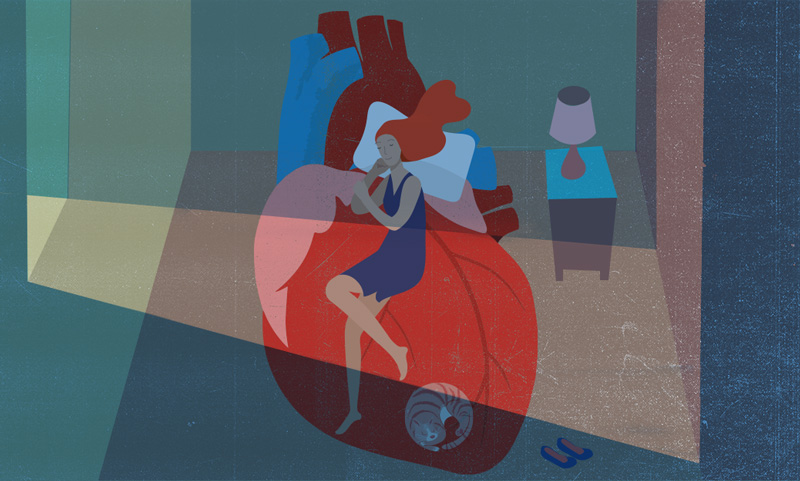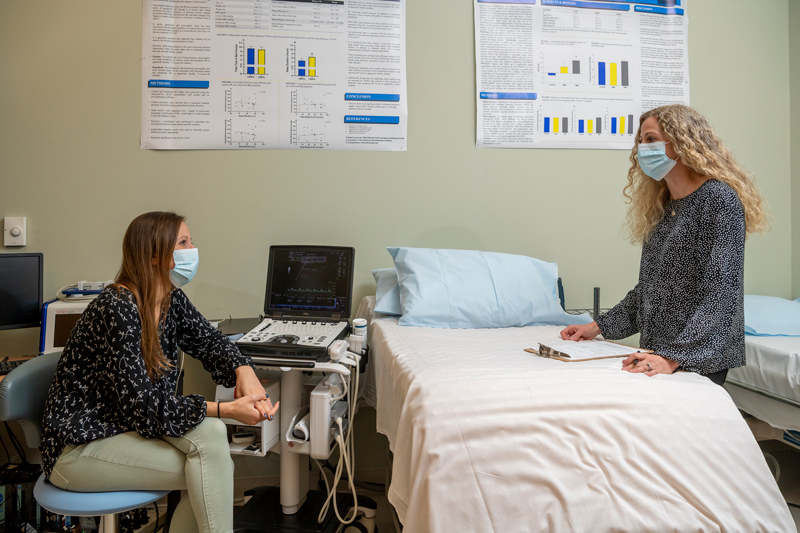


Sleep regularly
Illustration by Jeffrey C. Chase | Photos by Kathy F. Atkinson December 01, 2020
UD’s Hoopes and collaborators show consistent sleep relates to preserved cardiovascular function
It may seem like a good idea at the time — staying up late or pulling an all-nighter to study, celebrate or get to your destination faster — but it is probably not the health-savvy choice.
And those “recovery” days — the days you try to get more sleep to make up for those lost nights? Not as helpful as you might think.
A new study by a team of researchers in the University of Delaware’s College of Health Sciences suggests that consistently sleeping the same amount every night is associated with better cardiovascular health. Irregular sleep may increase the risk of developing cardiovascular disease, even in otherwise healthy, young adults.
The study was published in the peer-reviewed journal Sleep, which focuses on sleep and circadian science and is the official publication of the Sleep Research Society.
Fifty-one healthy undergraduate students participated in the study, wearing a biosensing device — wrist accelerometers, similar to the fitness and sleep trackers worn by many — 24 hours a day for 14 days. Along with sleep monitoring, participants were tested for vascular function and blood samples were drawn and analyzed.
“The vascular system — blood vessel health — is one of the first areas we’ll see damage before actual development of clinical cardiovascular disease,” said Elissa Hoopes, lead author on the paper.

Hoopes, who earned her doctorate at UD in May, now is a postdoctoral associate with Freda Patterson, associate professor in the Department of Behavioral Health and Nutrition.
Sleep-related research is growing in significance as scientists gain increasing insight into the effect sleep has on overall health. And because sleep is something people can control, recognizing and addressing poor sleep is a viable way to reduce risk factors. The earlier the better, Hoopes said.
“There is overwhelming support that sleep duration is important for cardiovascular health,” she said. “We should get seven or more hours of sleep per night to support heart health. But a lot of that information is derived from middle-age and older populations. This young-adult period has been kind of glossed over. And the key here is that cardiovascular disease develops over a lifetime.”
This is the first study to assess “free-living” sleep duration and regularity and their associations with vascular function in young adults. That “free-living” factor means the study was not done in a sleep lab, where participants are in a highly controlled and regimented setting, which typically includes being hooked to monitors and multiple sensors to evaluate sleep. This study was done with healthy young adults living in the wild, so to speak — their own apartments, residence hall rooms, houses.

Though it focused on young adults in free-living settings, the results track with other sleep lab studies that show microvascular (small arteries and blood vessels) impairment during sleep-restricted nights. In these studies, microvascular deficits continued even after a night of recovery sleep.
“The data more and more convincingly show that if you shorten your sleep, one good night of recovery sleep may help you feel better, but the physiological measures don’t rebound like we would hope,” Hoopes said. “These sleep lab studies might help explain our study results, where we were essentially capturing students repeating these patterns of shortened sleep and catch-up sleep over a two-week period, resulting in this erratic sleep schedule. It was those students who also had poorer vascular health.”
The study, which was supported in part by the National Institutes of Health-funded Center of Biomedical Research Excellence (COBRE) in Cardiovascular Health, also suggests the importance of the circadian rhythm for cardiovascular health, she said, maintaining the internal system that is wired for sleep and fasting when it is dark.
“Sleep is a biological necessity for members of the animal kingdom, including various insects, fish, reptiles, birds and mammals … and has stood the test of time as it is highly conserved across evolution,” said Melissa Witman, assistant professor in the Department of Kinesiology and Applied Physiology, who was Hoopes’ doctoral adviser. “However, to our knowledge, humans are the only ones that ‘override’ the physiological drive for sleep by artificial means, such as turning on lights when it gets dark or drinking caffeine when we are feeling drowsy. Unfortunately, irregular sleep patterns may be to our own detriment from a health and wellbeing standpoint.”
Within the 14-day period of this study, more than half of the participants got insufficient sleep (less than seven hours) on at least half of the 14 nights. And just over a third of participants only got “recovery” sleep (at least eight hours) once or twice during the period.
“I think we can certainly agree that staying up too late or pulling all-nighters are a bad idea,” Witman said. “And even though we went into this study expecting to see irregular sleep patterns in these young adults, we were surprised at just how bad they really were.”
Other research has shown that insufficient sleep (less than the recommended seven hours per night) is linked to problems including hypertension, coronary artery disease, Type 2 diabetes and death.
The current study looked at both sleep duration and sleep regularity and their association with peripheral vascular function, as measured by blood vessel responsiveness and blood flow during passive leg movement. Sleep regularity specifically was found to be a factor in microvascular function.
Promoting not only adequate but also consistent sleep is a potential strategy for protecting cardiovascular health.
It’s a worthwhile effort for all students, but it’s not necessarily easy.
“School start times for children — at least at that age there’s consistency. You have to be at school at a specific time,” Hoopes said. “You lose that in college. You’re transitioning to independence, class schedules can be very inconsistent and your socializing schedule plays a big role. Technology does, too — with people on their phones or computers all night long.”
It might be smarter to set a “time to sleep” alarm in the evening than setting an alarm to wake you up in the morning.
“As I’ve gone from my undergraduate days to my master’s and then my Ph.D., I find that I really value sleep,” she said. “I knew with the cognitive challenges of doing a Ph.D., you have to be rested to do that. To work hard, you have to sleep hard.”
The expansion of cardiovascular health research was one of the main reasons Witman was drawn to UD. Researchers in multiple departments — kinesiology and applied physiology, behavioral health and nutrition, biology — share an overall interest in this work, she said.
“But we all have slightly different areas of focus in regard to the populations we study and the models and techniques that we use,” she said. “This allows for both formal and informal collaborations and brainstorming that not only benefits our ongoing research efforts but also the training of the graduate and undergraduate students in our laboratories.”
Hoopes is an example of how such collaborative work gives students and trainees a breadth of experiences, Witman said.
“She is fast on her way to becoming an expert in the area of sleep research and I’m excited for the additional training that she will be receiving with Dr. Patterson,” she said. “When Elissa came to me she did not have a ton of research experience as she had received a clinical [master’s] degree but she is very smart and motivated and quickly got up to speed. Throughout her dissertation she became immersed in physiology research and is now gaining additional research training with more of a behavioral and epidemiological twist.”
In addition to Hoopes and Witman, co-authors of the paper included Michele D’Agata and Felicia Berube, both of whom are in the doctoral program in applied physiology, Patterson, Prof. William Farquhar and Prof. David G. Edwards.
Contact Us
Have a UDaily story idea?
Contact us at ocm@udel.edu
Members of the press
Contact us at 302-831-NEWS or visit the Media Relations website

